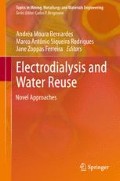Abstract
This chapter focuses on the general aspects of electrodialysis, presenting a historical background of the process and the technical principles. The electrodialysis stack design is introduced by discussing membranes, spacers and electrodes. Problems associated to fouling and scaling are presented. The phenomena known as fouling and scaling, which occur in membranes, can be avoided by applying the electrodialysis reversal. The basic concepts of electrodialysis reversal are presented. The efficiency of water and wastewater treatment by electrodialysis is evaluated through the calculation of percentage extraction and current efficiency. The total costs in electrodialysis are the sum of fixed costs associated with the amortization of the plant capital costs and the plant’s operating costs, which are discussed at the end of this chapter.
Access this chapter
Tax calculation will be finalised at checkout
Purchases are for personal use only
References
Allison RP (1991) Surface and wastewater desalination by electrodialysis reversal. In: American water works association membrane technology conference, Orlando, March 1991
Andrés LJ, Riera FA, Alvarez R et al (1994) Separation of strong acids by electrodialysis with membranes selective to monovalent ions. An approach to modelling the process. Can J Chem Eng 72:848–853. doi:10.1002/cjce.5450720511
Applegate LE (1984) Membrane separation processes. Chem Eng 91(12):64–89
Asada K, Gerdes L, Kawahara T (1992) Electrodialysis of effluents from treatment of metallic surfaces. In: Proceedings of 79th AESF annual technological conference, Atlanta, June 1992
Audinos R (1983) Optimization of solution concentration by electrodialysis. Aplications to zinc sulfate solutions. Chem Eng Sci 38(3):431–439. doi:10.1016/0009-2509(83)80160-2
Awwa Research Foundation (1996) Lyonnaise des eaux-Dumez (Firm), South Africa water research commission electrodialysis. Water treatment membrane processes. McGraw-Hill, New York
Ayala EB, Pourcelly G, Bazinet L (2006) Nature identification and morphology characterization of cation-exchange membrane fouling during conventional electrodialysis. J Colloid Interface Sci 300:663–672. doi:10.1016/j.jcis.2006.04.035
Baker RW (2004) Ion exchange membrane processes- electrodialysis. Membrane technology and applications, 2nd edn. John Wiley & Sons, New York. doi: 10.1002/9781118359686.ch10
Gavach C, Lebon F, Pourcelly G et al (1992) Polarization Phenomena at the interfaces between an electrolyte solution and ion exchange membrane. J Electroanal Chem 336(1–2):171–194. doi:10.1016/0022-0728(92)80270-E
Kariduraganavar MY, Kittur AA, Kulkarni SS (2012) Ion exchange membranes: preparation, properties, and applications. In: Inamuddin Dr., Luqman M (eds) Ion exchange technology I:theory and materials. Springer, pp 233–276. doi: 10.1007/978-94-007-1700-8
Leitz FB, Accomazzo MA, McRae WA (1974) High temperature electrodialysis. Desalination 14:33–41. doi:10.1016/S0011-9164(00)80045-4
Lindstrand V, Jonsson AS, Sundstrom G (2000) Organic fouling of electrodialysis membranes with and without applied voltage. Desalination 130:73–84. doi:10.1016/S0011-9164(00)00075-8
Lindstrand V, Sundstrom G, Jonsson AS (2000) Fouling of electrodialysis membranes by organic substances. Desalination 128:91–102. doi:10.1016/S0011-9164(00)00026-6
Rautenbach R, Albrecht R (1989) Electrodialysis. In: Membrane processes. John Wiley & Sons, Aarau, pp 333–362
Scott K (1997) Handbook of industrial membranes, 1st edn. Elsevier Advanced Technology, Oxford, p 912
Strathmann H (1991) Electrodialysis state of the art, membranes—proceedings of India-EC workshop. Oxford & IBH, New Delhi, pp 25–69
Strathmann H (1994) Electrodialytic membrane processes and their practical application. In: Sequeira CAC (ed) Studies in environmental science—environmental oriented electrochemistry, vol 59. Elsevier pp 495–533. doi: 10.1016/S0166-1116(08)70563-6
Strathmann H (1995) Electrodialysis and related processes. In: Noble RD, Stern SA (eds) Membrane separations technology: principles and applications. Elsevier Science, pp 213–281. doi: 10.1016/S0927-5193(06)80008-2
Strathmann H (2004) Ion exchange membrane separation processes, vol 9. Elsevier, Amsterdam, pp 1–348
Strathmann H (2010) Electrodialysis, a mature technology with a multitude of new applications. Desalination 264:268–288. doi:10.1016/j.desal.2010.04.069
Tanaka Y. (2007) Ion exchange membranes: fundamentals and applications, vol 12. Elsevier, Amsterdam, pp 1–531
Thampy SK, Narayanan PK, Chauhan DK et al (1995) Concentration of sodium sulfate from pickle liquor of tannery effluent by electrodialysis. Sep Sci Technol 30(19):3715–3722. doi:10.1080/01496399508014154
Valero-Cervera F, Barceló A, Arbós-Sans R (2011) Electrodialysis technology: theory and applications. In: Schorr M (ed) Desalination, trends and technologies. InTech, pp 3–20. doi: 10.5772/14297. Available from: http://www.intechopen.com/books/desalination-trends-and-technologies/electrodialysis-technology-theory-and-applications. Accessed 05 Nov 2012
Walsh FC, Pletcher D (1993) Industrial electrochemistry, 2nd edn. Chapman & Hall, London, pp 331–450
Wisniewska G, Winnicki T (1991) Electrodialytic desalination of effluents from zinc-coatings processes: removal of Zn\({\text{H}}^{+} \) and Cl− ions from model solutions. In: Proceedings of the 12th international symposium on desalination and water reuse, Malta, 15–18 April 1991, pp163–176
Author information
Authors and Affiliations
Corresponding author
Editor information
Editors and Affiliations
Rights and permissions
Copyright information
© 2014 Springer-Verlag Berlin Heidelberg
About this chapter
Cite this chapter
Moura Bernardes, A., Rodrigues, M.A.S., Ferreira, J.Z. (2014). General Aspects of Electrodialysis. In: Moura Bernardes, A., Siqueira Rodrigues, M., Zoppas Ferreira, J. (eds) Electrodialysis and Water Reuse. Topics in Mining, Metallurgy and Materials Engineering. Springer, Berlin, Heidelberg. https://doi.org/10.1007/978-3-642-40249-4_3
Download citation
DOI: https://doi.org/10.1007/978-3-642-40249-4_3
Published:
Publisher Name: Springer, Berlin, Heidelberg
Print ISBN: 978-3-642-40248-7
Online ISBN: 978-3-642-40249-4
eBook Packages: EngineeringEngineering (R0)

